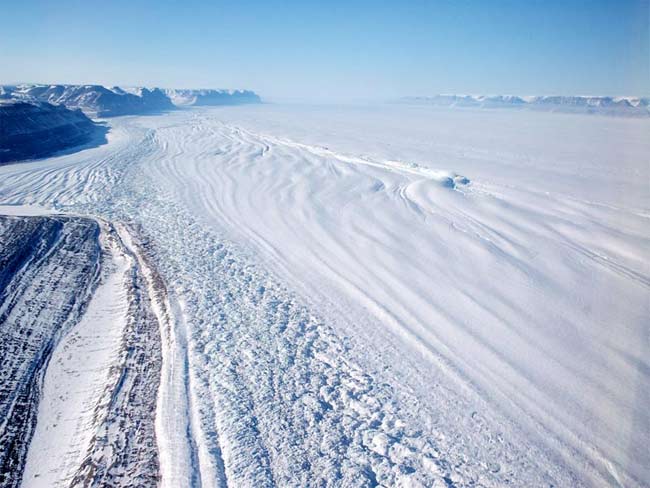Global Warming Good News: No More Ice Ages

Finally, there’s some "good" news about global warming: All that carbon dioxide we’ve emitted into the atmosphere could mean no more ice ages anytime soon, new research says.
Most research into the effects of the carbon dioxide accumulating in our atmosphere has looked ahead only to the next century or two.
But the emitted carbon dioxide isn't just going to disappear after that—research has shown that some of the carbon dioxide in the atmosphere now will hang around for quite awhile, probably tens or even hundreds of thousands of years. So the effects of burning fossil fuels today will extend long beyond the next couple hundred years, possibly delaying the onset of Earth's next ice age, says researcher Toby Tyrrell of the University of Southampton in the United Kingdom.
Advancing ice
Ice ages naturally occur about every 100,000 years or so as the pattern of Earth's orbit changes with time and alters the way the sun strikes the planet's surface.
When less solar energy hits a given area of the surface, temperatures become cooler (this is what causes the difference in temperatures between summer and winter). Long-term changes in Earth's orbit that cause less solar energy to hit the surface can cool down summer temperatures so that less ice melts at the poles.
If ice sheets and glaciers don't melt a bit in the summer, the ice accumulates and starts to advance—in past ice ages, sheets of ice covered all of Canada and most of the Northern United States.
Sign up for the Live Science daily newsletter now
Get the world’s most fascinating discoveries delivered straight to your inbox.
The level of carbon dioxide in the atmosphere is also an important factor in triggering an ice age. In the past, lower carbon dioxide levels (caused by natural processes) helped cool the Earth and again allowed ice to advance.
Rising carbon dioxide levels, as is the case with global warming, can have the opposite effect.
No more ice ages
Through the burning of fossil fuels, carbon dioxide is now accumulating in the atmosphere.
Tyrrell and his colleagues used a model to study what would happen if carbon dioxide continued to be emitted and how that would affect the long-term balance of carbon dioxide in the air and the ocean's chemistry.
The ocean is absorbing some of the carbon dioxide emitted into the air, which is causing it to become more acidic (similarly, the bubbles of carbon dioxide dissolved in your soda are what give it acidity).
Tyrrell and his team's model shows that carbon dioxide levels will be higher far into the future than previously predicted, because the acidifying ocean will dissolve more calcium carbonate from the shells of marine organisms, which acts as a buffer against acidification. But this buffer can only help to a certain point, and eventually the ocean won't be able to take up any more carbon dioxide.
"It can't just keep taking it up," said Joan Kleypas of the U.S. National Center for Atmospheric Research, who was not involved in the study.
The model results, detailed in a recent issue of the journal Tellus, project that 8 to 10 percent of the carbon dioxide emitted into the atmosphere will remain there for thousands of years, causing levels of the greenhouse gas to equilibrate in the atmosphere at twice their pre-industrial levels.
"It won't go back to original levels," Kleypas told LiveScience.
Even if we burn only a quarter of the Earth's total reserves of fossil fuels (currently we have burned less than one tenth of reserves), the carbon dioxide remaining in the atmosphere could cause the next ice age to be skipped because ice sheets and glaciers will have melted and won't be able to reform substantially, Tyrrell found.
In fact, burning up all of Earth's reserves would prevent the next five ice ages, the model shows, he said.
"Our research shows why atmospheric CO2 will not return to pre-industrial levels after we stop burning fossil fuels," Tyrrell said. "It shows that if we use up all known fossil fuels it doesn't matter at what rate we burn them. The result would be the same if we burned them at present rates or at more moderate rates; we would still get the same eventual ice-age-prevention result."
- Video: Goldilocks and the Greenhouse
- Top 10 Surprising Results of Global Warming
- Timeline: The Frightening Future of Earth

Andrea Thompson is an associate editor at Scientific American, where she covers sustainability, energy and the environment. Prior to that, she was a senior writer covering climate science at Climate Central and a reporter and editor at Live Science, where she primarily covered Earth science and the environment. She holds a graduate degree in science health and environmental reporting from New York University, as well as a bachelor of science and and masters of science in atmospheric chemistry from the Georgia Institute of Technology.









